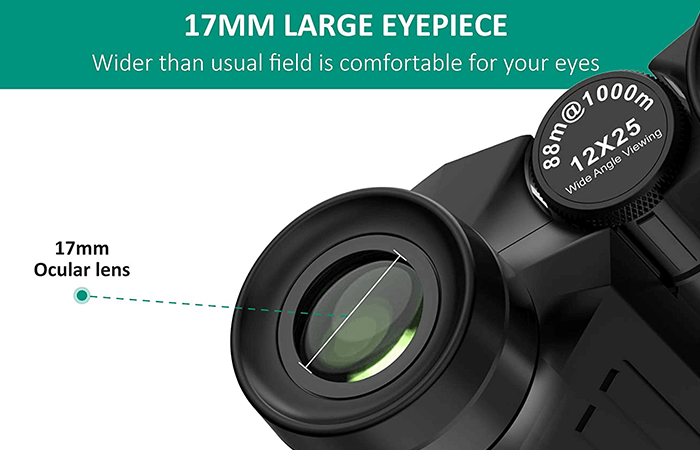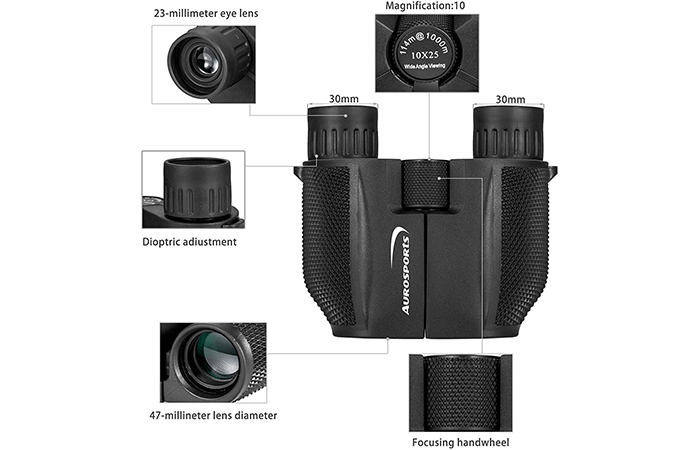Binoculars can help you get a magnified look at objects near and far. But choosing the best possible pair of binoculars for your adventures can be challenging if you’re not familiar with the binocular rating system.
Binocular rating represents the maximum magnification and aperture diameter of a specific pair of binoculars. The first number in the rating indicates the magnification and is always followed by the letter x. The second number stands for the aperture (or objective lens) size.
Let’s explore binocular ratings to discover how they work, what they mean, and how you can use them to your advantage when choosing a new pair of binoculars.
What Is Binocular Rating?
Every pair of binoculars has a rating that corresponds to its maximum magnification and aperture diameter. Understanding this rating is crucial to choosing the best optics for your needs.
For example, a budget-friendly or child-sized pair of binoculars might have a rating of 6×25 or 6×30. This is one of the lowest possible magnifications and aperture diameters. So, it’s best suited to individuals hoping to see relatively nearby objects with decent clarity.
But a 50×80 pair of binoculars might be relatively heavy, oversized, and powerful. These binoculars can zoom in on incredibly distant objects, such as stars, planets, and moons. However, they often carry so much weight and hefty in size so that they require a tripod or stand.
Some binoculars are designed for hunters, and others are geared toward bird watchers. Still, more are created for individuals watching live sports. Understanding how rating impacts capability is vital when picking the best pair.
To help you choose suitable binoculars for your favorite activities, we’ve broken down their rating into two primary categories, and when you understand these two factors, you can confidently choose a perfect pair of binoculars. Let’s get started!
Magnification Power Rating

Every pair of binoculars has a specific magnification rating or range. Traditional binoculars have a single magnification but zoom binoculars feature a variable magnification range.
A binocular’s magnification is a measurement that represents how large it can make distant images appear, and it can vary between 3x and 200x. Generally, the higher the magnification, the further the viewing distance.
The first number on a binocular rating represents the magnification power. You can refer to the chart below to figure out the ideal magnification and binocular rating for your new pair of binoculars.
If you’re hoping to see a magnified version of the landscape around you, an 8x pair might be the best option.
Hunters tracking game over medium distances might prefer an 8x to a 10x. That said, 10x binoculars offer more clarity and detail. If you’re planning to visit a theater or see a live sports game, a 10x pair of binoculars might be the right choice.
If you’re unsure which magnification might be best for your needs, visit your local camping and sporting goods store. Trying out different models and magnifications lets you develop a first-hand understanding of binocular ratings and how they influence each pair’s capabilities.
| Common Magnification Powers | Appropriate Tasks |
| 6x | Visiting the theater, bird watching at home |
| 8x | Viewing a live sports game from the stands, birdwatching at a park |
| 10x | Hunting medium-range live game, hiking |
| 16x | Stargazing |
| 20x | Wildlife viewing and photography |
| 25x | Stargazing, wildlife viewing, long-range hunting |
| 40x | Stargazing, wildlife viewing |
| 50x | Stargazing, wildlife viewing |
Aperture Diameter

All binoculars contain at least four lenses, two on each side. If you’re not sure what a lens is, think about a pair of eyeglasses. Each pair of eyeglasses contain two lenses. Binoculars work similarly, but with an extra pair of lenses.
The lens that sits closest to the viewer is called the eyepiece. The objective lens sits on the outside facing away from the user. Binoculars can’t enlarge images without both of these lenses.
However, the objective lens diameter has more of an impact since it determines both the overall size of the binoculars and their clarity. The larger the objective lens, the wider the binocular’s aperture.
Binoculars with massive apertures can take in more light than those with smaller ones, allowing them to produce brighter, clearer images.
Nevertheless, a pair of binoculars with large objective lenses are bound to be heavier and more challenging to balance than smaller, more compact options.
For this reason, the typical person might benefit from choosing a 25mm (0.98”) or 30mm (1.18”) pair of binoculars instead of an 80mm (3.15”) pair.
Unless you’re planning on viewing the surface of the moon with your new pair of binoculars, you’re a professional wildlife photographer, or you’re tracking an endangered species, there’s no reason to get binoculars with such massive objective lenses.
Check the following table to get a sense of the right aperture diameter for your needs.
| Aperture Diameter / Objective Lens Size | Appropriate Tasks |
| 25mm (.98”) | Casual short-range viewing, children’s binoculars |
| 30mm (1.18”) | Birdwatching at home, children’s binoculars, hiking |
| 40mm (1.57”) | Viewing live sports, birdwatching at a park, visiting the theater |
| 50mm (1.97”) | Stargazing, medium-range hunting |
| 60mm (2.36”) | Long-range hunting, wildlife viewing, photography, astronomy, and stargazing |
| 70mm (2.76”) | Wildlife viewing and photography, astronomy, and stargazing |
| 80mm (3.15”) | Wide field of view for astronomy and stargazing |
Final Thoughts: What Is Binocular Rating?
Every pair of binoculars has a rating representing its magnification power and aperture diameter (also called objective lens size).
Choosing the best pair of binoculars often requires understanding and utilizing this rating system.
The first number in the rating represents magnification: 8x and 10x are the most common. The second number after the X represents the aperture diameter. The aperture diameter determines how detailed the images are, as well as the size of the binoculars.
Related Articles:
- What Is Close Focus on Binoculars
- How Much Do Binoculars Weigh
- Can You Use Hunting Binoculars for Stargazing
- How Far Can Night Vision Binoculars See
- Monocular vs Binocular

